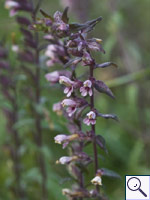|
||||||
|
ODONTITES. Bartsias. [Scrophulariaceae] |
|
|
Two species of Odontites are recorded in Britain. These include the native Red Bartsia (O. vernus) and the introduced French Bartsia (O. jaubertianus). Only one British miner is recorded on Odontites. A key to the European miners recorded on Odontites is provided in Bladmineerders van Europa. |
 Red Bartsia Odontites vernus |
Key for the identification of the known mines of British |
1 > Leaf-miner: Oviposition takes place in an upper leaf and a short mine is formed either in the leaf or stem, but the larva feeds primarily in the stem. Pupating in the stem (Spencer, 1976: 487 (fig. 857), 488). Short and narrow corridor in the leaves, bracts or even calyx, ending in a thick vein. From there the larva descends as a borer. Infested plants largely die off. Pupation and hibernation within the mine. |
|
Phytomyza rostrata Hering, 1934 [Diptera: Agromyzidae]. |
| Last updated 06-Jul-2019 Brian Pitkin | ||
